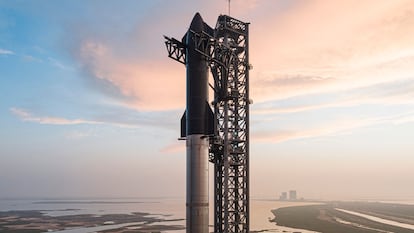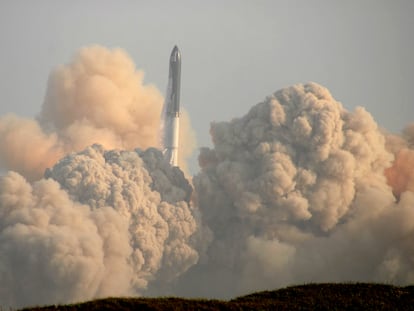SpaceX ‘Starship’ launch: The keys to Elon Musk’s second attempt
After an FAA ruling last April following the failure of the first test launch, the private space company has modified its craft and launch pad to meet authorization requirements

The second Starship launch attempt is imminent, after the U.S. Federal Aviation Administration announced that it has granted SpaceX authorization to test-fly its mega rocket. Elon Musk’s company will attempt to achieve liftoff on Saturday November 18 during a twenty-minute launch window that opens at 7:00 CT at the SpaceX base in Boca Chica, Texas, where the rocket is already waiting on its launch pad.
If Starship completes the test successfully this time, it will become the largest and most powerful space rocket in history. Beyond records, the importance of this fully reusable spacecraft lies in the role NASA has afforded it as a vehicle for the first woman to set foot on the Moon as part of the Artemis missions, and in Musk’s plans to reach Mars.
However, despite what the future may hold, fresh in everyone’s memory is the outcome of Starship’s first flight attempt: the rocket broke apart after almost four minutes of flight due to a serious failure, while the launch pad was turned into a huge sinkhole, punctured by the exhausts of the 33 engines, and damage was caused in the immediate vicinity due to the blast debris resulting from liftoff.
Given such an outcome, many experts believed a second attempt would be delayed for more than a year. SpaceX, however, preferred to look on the bright side: the super rocket had lifted off and the launch tower remained intact.
Why did the first launch create so much damage?
Basically, because the brutal power of the engine exhausts impacted directly on the concrete of the rocket’s launch pad. In theory it was constructed from a special concrete, resistant to high temperatures, so engineers elected not to wait until they had installed a water-cooling system, which would have protected the pad.
What damage was caused?
A crater several meters deep was left under the launch pad, exposing the foundation. Large chunks of concrete flew like a hailstorm in all directions, some denting the large methane and oxygen tanks a hundred meters away; others shattered the windows of a van parked in the supposed safety zone. And some even hit the rocket engines themselves, causing the premature shutdown of at least six out of a total of 33.
Numerous federal agencies, including the Environmental Protection Agency, revoked SpaceX’s authorization to continue launching from Boca Chica, which is located next to a natural park on the Gulf of Mexico coast. Even NASA expressed its concern, as Musk’s company is building a similar launch tower next to pad 39A at NASA’s Cape Canaveral base. Besides other considerations, 39A is a historic site from where the first flight to the Moon was launched, which justified asking SpaceX for assurances regarding future launches.
Targeting Friday, November 17 for Starship’s second flight test. A two-hour launch window opens at 7:00 a.m. CT → https://t.co/bJFjLCiTbK pic.twitter.com/4t3AfRke8h
— SpaceX (@SpaceX) November 15, 2023
What has caused so many SpaceX failures?
So far, these have only occurred during development flights. The Falcon rocket crashed 10 times before achieving the first soft landing. But that was eight years ago. Now, for SpaceX, recovering the lower stage of those rockets is pure routine. They have already flown 250 Falcons, with a failure rate of less than 5%, almost all concentrated in the first stage. Thirty-nine first stages are continually recycled on successive launches. One of them has been reused on 18 occasions. The economic advantage of this over other companies’ disposable rockets is obvious.
Is it reasonable to suffer so much failure?
SpaceX claims to follow a “design, test, fix, and repeat” philosophy. It is a private company that can afford to accumulate failures to accelerate development. From each one, conclusions are drawn that allow mistakes to be corrected until the final product is reliable - so reliable that it has already been entrusted with the launching of astronauts and even the U.S. Department of Defense has contracted SpaceX to put military satellites into orbit.
The case of NASA is diametrically opposed. It operates with federal funds and therefore cannot afford any failure if it does not want to see its yearly budget compromised. However, it takes years and years for NASA projects to materialize; and it is rare that they are executed within budget.
What improvements has Starship incorporated for this second launch?
First and foremost, the installation of a water-cooling system for the platform, which is basically an upside-down shower, which throws up a waterfall just before engine ignition. That should protect the concrete and, at the same time, absorb some of the brutal acoustic energy it gives off.
The decoupling system for the two parts of the rocket (the upper and lower stages), which did not work last time, has also been redesigned. The idea is for it to separate spontaneously by opening the clamps that join the two stages, rotating the rocket on itself and letting the centrifugal force itself separate the lower stage, which will already be almost empty of fuel and, therefore, very light.
In any case — and in case the theory doesn’t work in practice — the ring connecting the two segments is a new design, perforated with large vertical grooves. If the separation fails and the upper stage engines are nevertheless started, the gases will escape through it. This system has been used by the Russians on their Soyuz rockets for three-quarters of a century.
The limitations of a test flight
If all goes well, Starship will complete a trajectory with such a low perigee that it will fall before completing a single circuit of the Earth. It should crash into the Pacific Ocean near Hawaii without a controlled landing being attempted. Although both stages of the rocket will be recoverable in the future, on this occasion neither will be rescued. For now, the main interest is to see if the rocket lifts off smoothly and its payload completes almost one orbit.
The loss of the two parts of such a complex vehicle is part of SpaceX’s plans. At its Boca Chica factory, the company is producing Starships almost on an assembly line basis. The one on the launchpad now is number 25 and its booster is number 9. They are made from stainless steel, not exotic alloys, and their Raptor engines use many parts (e.g., the turbopump) that are 3D printed, reducing both their cost and assembly time. SpaceX claims to be producing one Raptor a day, valued at $250,000; 50 years ago, each F-1 engine powering the Saturn 5 rocket on the lunar missions was worth $15 million (at the time) and was produced at a rate of 10 or 12 a year.
The next step, if this test is a success, is not yet clear. SpaceX is a private company that does not disclose many details about its plans, as many are trade secrets. However, it has a commitment with NASA to develop the lunar landing spacecraft — based precisely on the upper stage of the Starship rocket — for the Artemis missions scheduled to land on the Moon from 2025 onwards.
To make that future lunar mission a reality, SpaceX will first have to achieve in-orbit refueling, a maneuver never tested on the scale involved in refilling the tanks of a Starship. As such, Musk’s immediate plans are likely to go along the lines of first reaching orbit and then testing refueling. That would mean at least two or three more launches of his mega-rocket. Perhaps as early as next year.
Sign up for our weekly newsletter to get more English-language news coverage from EL PAÍS USA Edition
Tu suscripción se está usando en otro dispositivo
¿Quieres añadir otro usuario a tu suscripción?
Si continúas leyendo en este dispositivo, no se podrá leer en el otro.
FlechaTu suscripción se está usando en otro dispositivo y solo puedes acceder a EL PAÍS desde un dispositivo a la vez.
Si quieres compartir tu cuenta, cambia tu suscripción a la modalidad Premium, así podrás añadir otro usuario. Cada uno accederá con su propia cuenta de email, lo que os permitirá personalizar vuestra experiencia en EL PAÍS.
¿Tienes una suscripción de empresa? Accede aquí para contratar más cuentas.
En el caso de no saber quién está usando tu cuenta, te recomendamos cambiar tu contraseña aquí.
Si decides continuar compartiendo tu cuenta, este mensaje se mostrará en tu dispositivo y en el de la otra persona que está usando tu cuenta de forma indefinida, afectando a tu experiencia de lectura. Puedes consultar aquí los términos y condiciones de la suscripción digital.











































